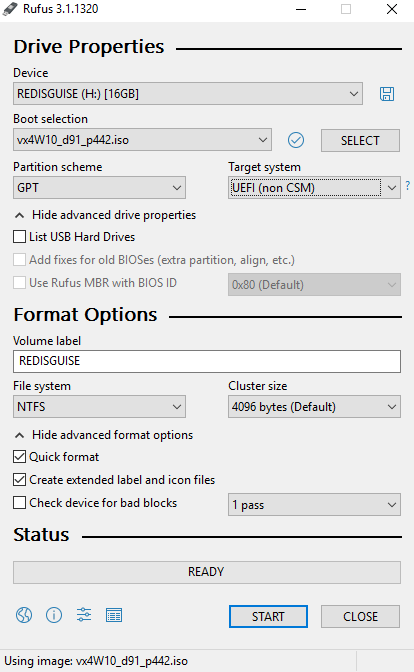Redisguise vx
The process for reimaging a vx server from a USB drive.
The reimaging process we refer to as Redisguise is the process of performing an update or restore on the system using a bootable USB drive. This process does not affect the media drive.
Please note: If you experience any problems during updating or restoring the system, or any of these instructions are unclear, please contact the support team.
Warning: The system needs to be connected to the internet during this procedure
This process can be used to update to a newer OS image, or revert to a previous OS image.
To tell what OS image your system is on please go to the Help menu in d3manager and select About Manager.
If you are updating from an OS earlier than 3.0 your system will do a cold reboot as it performs firmware level updates to some of the components. Please don't be alarmed, just switch the system back on again using the power button
You will need
-
A 32Gb USB memory stick
-
A version of Rufus to turn it into a bootable disk. Make sure the volume name of the usb is: "REDISGUISE" as per image
-
An internet connection to the machine you are re-imaging
-
Download and install a version of 7Zip
-
Download and unzip the multi file archive using 7Zip
-
OS images can be found here.
Please note: You do not need to extract all parts individually. Simply place them in the same directory and then use 7zip to extract the ISO by selecting any part. 7zip will automatically unzip all parts to create the image file.
Create Bootable USB device
-
Download and unzip the multi file archive using 7Zip (NOTE: you will only need to unzip file 001):
.png)
-
Create Bootable USB stick with the unzipped ISO.
The settings should be:
-
Partition scheme - GPT (vx range)
-
Target system - UEFI - non CSM
-
Volume label - automatically pulled from ISO file
-
File system - NTFS
Warning: These settings are critically important. The re-image process will fail if they are not set correctly.
-
Booting into the USB
-
Go into the BIOS by hitting Delete on the logo splash screen during boot.
-
Change the Boot option #1 to the USB stick
-
Navigate to the Advanced tab and press enter to view the CSM Configuration and ensure that Boot option filter is set to [UEFI and Legacy]. Change it if it is not, then press F4, confirm and re-enter BIOS.
-
Once this setting is confirmed, navigate to the Save & Exit tab. It is just to the right of the Boot tab.
-
In the Boot Override section at the bottom there is a UEFI: USB, Partition 2. This may vary depending on the manufacturer of USB stick in use. Select this option to begin the OS upgrade process.
Please note: performing a system restore from the new disk image will erase any valuable data on your system drive. Please ensure you make a back up of any essential files from your system (C:) drive before initialising this process. The process does NOT destroy any media or projects on your media drive.
